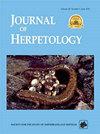蒙特沙漠入侵种牛蛙蝌蚪(Lithobates catesbeianus, Shaw 1802)的饮食
IF 0.8
4区 生物学
Q3 ZOOLOGY
引用次数: 0
摘要
摘要蝌蚪之间的竞争效应使牛蛙可能成为引进地本地两栖动物数量下降的原因。我们的目的是分析一个入侵种群的饮食组成,并评估在活动月份的饮食变化程度。我们假设,牛蛙蝌蚪的饮食会出现时间变化,与蝌蚪大小和资源可用性的变化相一致。收集了94只牛蛙蝌蚪,在其消化道中鉴定出50个分类群。食用频率最高的是Navicula属微藻(出现频率[Fo] = 19)和Cymbella(出现频率[Fo] = 17)。生态位宽度为8.13,属于中高。黑斑夜蛾幼虫的营养习性随季节变化,10月和12月的食性数值相近(Morisita定量指数= 0.86)。8月和10月日粮组成相似度为63% (Jaccard’s quality index)。不同月份采集的斑夜蛾幼虫在发育阶段和体质量上存在显著差异。平均而言,个体在12月份更大,更发达,这是意料之中的,因为猎物的丰度在夏季是最大的。我们的研究结果表明,L. catesbeianus蝌蚪具有广泛的营养生态位,其饮食选择性不强;因此,水生生活史阶段在入侵无尾蝇幼虫群落的结构中起着重要作用。本文章由计算机程序翻译,如有差异,请以英文原文为准。
Diet of Bullfrog Tadpoles Lithobates catesbeianus, Shaw 1802, an Invasive Species from Monte Desert
Abstract. The competitive effects among tadpoles make the bullfrog a possible agent of native amphibian population declines at its introduction sites. Our aim was to analyze the dietary composition of an invasive population of Lithobates catesbeianus tadpoles and to evaluate the degree of dietary changes among activity months. We hypothesized that bullfrog tadpoles would exhibit temporal changes in diet, consistent with the variation of tadpole size and availability of resources. We collected 94 bullfrog tadpoles and identified 50 taxa in their digestive tracts. The items most frequently consumed were microalgae of the genera Navicula (frequency of occurrence [Fo] = 19) and Cymbella (Fo = 17). The trophic niche breadth was 8.13, which is considered moderate-high. The trophic habits of L. catesbeianus larvae changed seasonally, with the diets during October and December being numerically similar (Morisita's quantitative index = 0.86). The composition of the diet had a similarity of 63% (Jaccard's qualitative index) between August and October. The larvae of L. catesbeianus collected during the different months showed significant differences in their stages of development and body mass. On average, individuals were larger and more developed in the month of December, which was to be expected given that the abundance of prey items is greatest during the summer season. Our results show that L. catesbeianus tadpoles have a wide trophic niche with a diet that is not strongly selective; thus, the aquatic life-history stages play an important role in the structuring of invaded anuran larval communities.
求助全文
通过发布文献求助,成功后即可免费获取论文全文。
去求助
来源期刊

Journal of Herpetology
生物-动物学
CiteScore
1.60
自引率
0.00%
发文量
45
审稿时长
6 months
期刊介绍:
The Journal of Herpetology accepts manuscripts on all aspects on the biology of amphibians and reptiles including their behavior, conservation, ecology, morphology, physiology, and systematics, as well as herpetological education. We encourage authors to submit manuscripts that are data-driven and rigorous tests of hypotheses, or provide thorough descriptions of novel taxa (living or fossil). Topics may address theoretical issues in a thoughtful, quantitative way. Reviews and policy papers that provide new insight on the herpetological sciences are also welcome, but they must be more than simple literature reviews. These papers must have a central focus that propose a new argument for understanding a concept or a new approach for answering a question or solving a problem. Focus sections that combine papers on related topics are normally determined by the Editors. Publication in the Long-Term Perspectives section is by invitation only. Papers on captive breeding, new techniques or sampling methods, anecdotal or isolated natural history observations, geographic range extensions, and essays should be submitted to our sister journal, Herpetological Review.
 求助内容:
求助内容: 应助结果提醒方式:
应助结果提醒方式:


